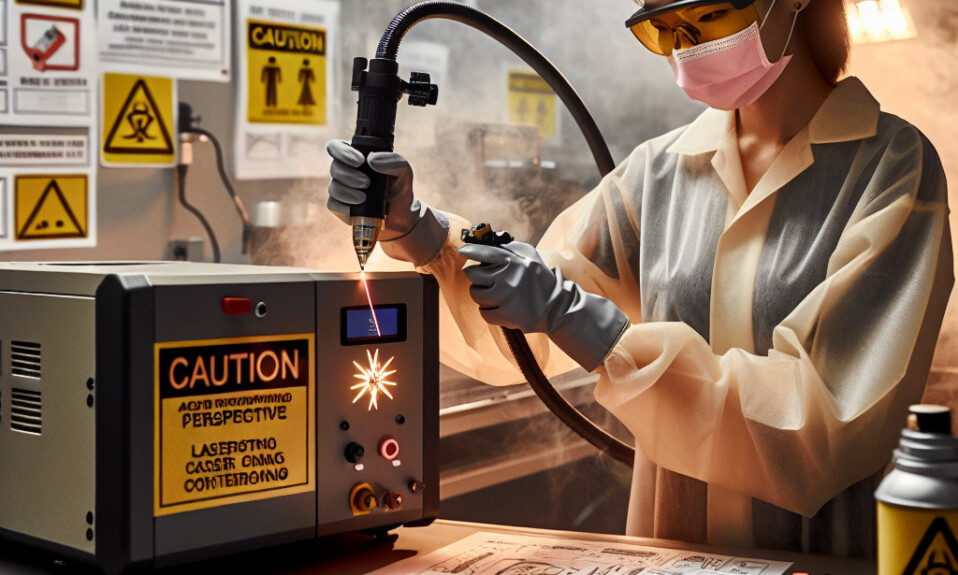- The principles of laser cleaning and how it works
- The potential hazards and risks associated with laser cleaning
- The environmental impact of laser cleaning compared to other cleaning methods
- The training and certification requirements for laser safety officers in charge of overseeing laser cleaning operations
- The role of safety interlocks and emergency stop mechanisms in preventing accidents during laser cleaning operations
- The potential risks of chemical exposure from cleaning agents used in conjunction with laser cleaning technology
- The potential risks of laser-induced damage to optical components or lenses during cleaning operations
- The cost-effectiveness of laser cleaning in the long run
The principles of laser cleaning and how it works
Laser cleaning is a highly effective method of removing contaminants from surfaces without causing damage. It works by using a focused laser beam to vaporize or ablate the unwanted material, leaving behind a clean surface. Here are the key principles of laser cleaning and how it works:
1. Selective absorption: The laser beam is absorbed by the contaminant on the surface, causing it to heat up and vaporize. This selective absorption allows for precise cleaning without affecting the underlying material.
2. Non-contact: Laser cleaning is a non-contact process, meaning that the laser beam does not physically touch the surface being cleaned. This eliminates the risk of damage to delicate materials and allows for cleaning in hard-to-reach areas.
3. High precision: The focused laser beam can be controlled with great precision, allowing for targeted cleaning of specific areas. This makes laser cleaning ideal for removing contaminants from intricate or complex surfaces.
4. No residue: Unlike traditional cleaning methods that can leave behind residue or waste, laser cleaning produces minimal waste material. The vaporized contaminants are simply removed from the surface, leaving it clean and residue-free.
5. Environmentally friendly: Laser cleaning is a clean and environmentally friendly process that does not require the use of harsh chemicals or solvents. This makes it a sustainable cleaning solution for a wide range of applications.
Overall, laser cleaning is a versatile and efficient method for removing contaminants from surfaces with precision and minimal impact. Its non-contact nature, high precision, and environmentally friendly properties make it a preferred choice for industries such as aerospace, automotive, and electronics.
#laser #cleaning #principles #noncontact #precision #environmentallyfriendly
frazy kluczowe:
– Highly effective method of removing contaminants
– Selective absorption for precise cleaning
– Non-contact process for delicate materials
– High precision for targeted cleaning
– Environmentally friendly and sustainable cleaning solution
The potential hazards and risks associated with laser cleaning
Potential hazards:
| Hazard | Description |
|---|---|
| Eye damage | Laser beams can cause permanent eye damage if proper eye protection is not used. |
| Skin burns | Direct exposure to laser beams can cause burns to the skin. |
| Fires | Laser beams can ignite flammable materials, leading to fires. |
| Toxic fumes | Some materials can release toxic fumes when exposed to laser beams. |
Risks:
| Risk | Description |
|---|---|
| Improper training | Operators who are not properly trained in laser cleaning techniques may not follow safety protocols. |
| Equipment malfunction | Malfunctioning equipment can lead to accidental exposure to laser beams. |
| Environmental impact | Improper disposal of materials cleaned with lasers can have negative environmental consequences. |
It is important for companies and individuals using laser cleaning technology to be aware of these potential hazards and risks and take appropriate measures to mitigate them. This includes providing proper training to operators, using protective gear, regularly maintaining equipment, and following safety guidelines.
By understanding and addressing the hazards and risks associated with laser cleaning, companies can ensure the safety of their workers and the environment while still benefiting from the efficiency of this cleaning method.
#laser #cleaning #hazards #risks #safety #training #equipment #environmental impact
The environmental impact of laser cleaning compared to other cleaning methods
Advantages of laser cleaning:
– 🌱 Laser cleaning does not require the use of chemicals, reducing the amount of hazardous waste produced.
– 🌍 It is a non-abrasive method, which means it does not create dust or particles that can pollute the air.
– ♻️ Laser cleaning is a sustainable method as it does not generate any secondary waste.
Disadvantages of traditional cleaning methods:
– 🚫 Many traditional cleaning methods rely on the use of harsh chemicals that can be harmful to the environment and human health.
– 🏭 Some methods, such as sandblasting or chemical cleaning, can produce a large amount of waste that needs to be disposed of properly.
– 🌫️ Traditional cleaning methods can also contribute to air pollution through the release of harmful fumes and particles.
Comparison:
When comparing laser cleaning to traditional cleaning methods, it is clear that laser cleaning has a much lower environmental impact. Not only does it eliminate the need for harmful chemicals, but it also reduces waste and air pollution. Additionally, laser cleaning is a more precise and efficient method, which can lead to energy savings in the long run.
Overall, laser cleaning is a more environmentally friendly option for cleaning surfaces compared to traditional methods. By choosing laser cleaning, businesses and individuals can help reduce their carbon footprint and contribute to a cleaner and healthier planet.
#environment #laser cleaning #sustainability #cleaning methods
Long-tail keywords:
– Environmental impact of laser cleaning
– Sustainable cleaning methods
– Benefits of laser cleaning for the environment
The training and certification requirements for laser safety officers in charge of overseeing laser cleaning operations
Training requirements
Training for laser safety officers typically includes a combination of classroom instruction and hands-on experience with laser equipment. The specific requirements for training may vary depending on the type of lasers being used and the industry in which they are employed. However, some common training topics include:
| Training Topic | Description |
|---|---|
| Laser safety regulations | Understanding the regulations and guidelines set forth by organizations such as OSHA and ANSI. |
| Laser classification | Learning how to classify lasers based on their potential hazards and safety requirements. |
| Personal protective equipment | Identifying and using the appropriate PPE to protect against laser hazards. |
| Emergency procedures | Knowing how to respond in the event of a laser-related emergency. |
Certification requirements
Once the training is complete, laser safety officers must pass a certification exam to demonstrate their knowledge and competency in laser safety. Certification requirements may vary depending on the industry and the specific duties of the officer, but typically include:
| Certification Requirement | Description |
|---|---|
| Written exam | A comprehensive exam covering all aspects of laser safety and operation. |
| Practical exam | A hands-on demonstration of the officer’s ability to safely operate laser equipment. |
| Continuing education | Regular training and updates to stay current on laser safety regulations and best practices. |
Overall, the training and certification requirements for laser safety officers are designed to ensure that these individuals have the knowledge and skills necessary to protect themselves and others from the potential hazards of laser use. By meeting these requirements, laser safety officers can help prevent accidents and create a safe work environment for all personnel involved in laser cleaning operations.
#laser safety officers, laser cleaning operations, training requirements, certification requirements, laser safety regulations, laser classification, personal protective equipment, emergency procedures, written exam, practical exam, continuing education
frazy kluczowe:
– training and certification requirements for laser safety officers
– overseeing laser cleaning operations
– laser safety regulations and guidelines
– laser classification and hazards
– personal protective equipment for laser use
– emergency procedures for laser-related accidents
– certification exams for laser safety officers
– continuing education for laser safety officers
The role of safety interlocks and emergency stop mechanisms in preventing accidents during laser cleaning operations
Safety Interlocks
Safety interlocks are devices that are designed to prevent the laser cleaning equipment from operating if certain safety conditions are not met. These conditions may include the presence of a trained operator, proper ventilation in the workspace, and the use of appropriate personal protective equipment. Safety interlocks can be integrated into the equipment itself or installed as separate devices that must be activated before the equipment can be used.
Table 1: Examples of safety interlocks
| Interlock Type | Description |
|---|---|
| Keyed interlock switch | Requires a key to be inserted before the equipment can be operated |
| Light curtain | Uses beams of light to detect the presence of objects in the workspace |
| Emergency stop button | Allows the operator to quickly shut down the equipment in case of an emergency |
Emergency Stop Mechanisms
Emergency stop mechanisms are devices that allow the operator to quickly shut down the laser cleaning equipment in case of an emergency. These mechanisms are typically located in easily accessible locations and are designed to be activated with minimal effort. In addition to preventing accidents, emergency stop mechanisms can also help to minimize damage to the equipment in case of a malfunction.
Table 2: Examples of emergency stop mechanisms
| Emergency Stop Type | Description |
|---|---|
| Push-button emergency stop | Requires the operator to push a button to shut down the equipment |
| Pull-cord emergency stop | Requires the operator to pull a cord to shut down the equipment |
| Foot pedal emergency stop | Allows the operator to shut down the equipment with their foot |
By implementing safety interlocks and emergency stop mechanisms, companies can ensure that their laser cleaning operations are conducted safely and efficiently. These devices help to prevent accidents, protect operators from harm, and minimize damage to equipment. It is essential for companies to prioritize safety in all aspects of their operations, including the use of laser cleaning equipment.
#safety #interlocks #emergency #stop #mechanisms #laser #cleaning #accidents #prevention
Keywords: safety interlocks, emergency stop mechanisms, laser cleaning operations, accidents prevention, equipment safety
Long-tail phrases: importance of safety interlocks in laser cleaning, benefits of emergency stop mechanisms in preventing accidents during laser cleaning operations
The potential risks of chemical exposure from cleaning agents used in conjunction with laser cleaning technology
Another concern is the potential for long-term health effects from repeated exposure to these chemicals. Studies have shown that certain cleaning agents can be carcinogenic or have other harmful effects on the body over time. Workers who are regularly exposed to these chemicals may be at an increased risk for developing serious health conditions, such as cancer or respiratory diseases.
Furthermore, the use of chemical cleaning agents can have negative impacts on the environment. Many cleaning agents contain toxic substances that can leach into the soil and water supply, causing pollution and harm to wildlife. In addition, the production and disposal of these chemicals can contribute to air and water pollution, further exacerbating environmental issues.
It is important for companies that use laser cleaning technology in conjunction with chemical cleaning agents to take steps to mitigate these risks. This can include providing proper training and protective equipment to workers, implementing safe handling and disposal procedures for chemicals, and exploring alternative cleaning methods that do not rely on harsh chemicals.
Table of potential risks from chemical exposure:
| Risk | Description |
|---|---|
| Skin irritation | Chemicals can cause rashes, burns, and other skin conditions |
| Respiratory problems | Inhaling fumes can lead to coughing, wheezing, and shortness of breath |
| Long-term health effects | Repeated exposure can increase the risk of cancer and other serious health conditions |
| Environmental impact | Chemicals can leach into soil and water, causing pollution and harm to wildlife |
In conclusion, the potential risks of chemical exposure from cleaning agents used in conjunction with laser cleaning technology are significant and should not be overlooked. Companies must take proactive measures to protect workers and the environment from these risks, including implementing proper safety protocols and exploring alternative cleaning methods. By prioritizing safety and sustainability, companies can minimize the negative impacts of chemical exposure and ensure a healthier workplace for all.
#chemicals #cleaningagents #laser #technology #risks #exposure #skinirritation #respiratoryproblems #longtermhealtheffects #environmentalimpact #safetyprotocols #sustainability #workplacehealth #alternativecleaningmethods.
The potential risks of laser-induced damage to optical components or lenses during cleaning operations
One of the main risks of laser-induced damage is thermal stress. When a laser beam is focused on a small area of an optical component, it can generate intense heat, leading to thermal expansion and contraction. This rapid temperature change can create microcracks or fractures in the material, compromising its structural integrity. In extreme cases, the optical component may shatter, rendering it unusable.
Another risk of laser-induced damage is surface ablation. As the laser beam interacts with the surface of the optical component, it can vaporize or ablate the material, causing pits or rough spots. This can affect the optical properties of the component, leading to decreased performance or image quality. In addition, the debris generated during ablation can contaminate other parts of the optical system, further compromising its functionality.
To mitigate the risks of laser-induced damage during cleaning operations, several precautions should be taken. First, it is essential to use the appropriate laser parameters, such as wavelength, pulse duration, and energy density, to minimize thermal stress and ablation. Additionally, operators should ensure proper alignment and focusing of the laser beam to avoid unintended damage to the optical components.
Furthermore, protective measures such as using laser safety goggles and shields should be implemented to prevent accidental exposure to the laser beam. Regular inspection and maintenance of the optical components are also crucial to detect any signs of damage early on and prevent further deterioration.
In conclusion, while laser cleaning can be an effective method for removing contaminants from optical components, it also poses potential risks of damage if not performed carefully. By following proper procedures and safety precautions, operators can minimize the likelihood of laser-induced damage and ensure the longevity of optical systems.
- thermal stress
- surface ablation
- laser parameters
- protective measures
- inspection and maintenance
#laser-induced damage, #optical components, #cleaning operations, #thermal stress, #surface ablation, #laser parameters, #protective measures, #inspection and maintenance
Keywords: laser-induced damage, optical components, cleaning operations, thermal stress, surface ablation, laser parameters, protective measures, inspection and maintenance
The cost-effectiveness of laser cleaning in the long run
Benefits of laser cleaning
One of the main advantages of laser cleaning is its ability to remove contaminants without the need for chemicals or abrasive materials. This not only reduces the environmental impact of cleaning processes but also eliminates the cost of purchasing and disposing of these materials. Additionally, laser cleaning is a non-contact process, which means that there is no risk of damage to the surface being cleaned.
Another benefit of laser cleaning is its efficiency. Laser systems can be programmed to target specific contaminants, making the cleaning process faster and more precise than traditional methods. This can result in reduced downtime and increased productivity for businesses that rely on clean surfaces for their operations.
Cost-effectiveness of laser cleaning
While the initial cost of purchasing a laser cleaning system may be higher than traditional cleaning methods, the long-term cost savings can outweigh this investment. Laser systems are durable and require minimal maintenance, which can reduce the overall cost of ownership over time. Additionally, the efficiency of laser cleaning can lead to savings in labor costs and increased productivity.
Furthermore, the environmental benefits of laser cleaning can result in cost savings for businesses. By eliminating the need for chemicals and abrasive materials, businesses can reduce their impact on the environment and avoid potential fines for improper disposal. This can also improve the reputation of a business and attract environmentally conscious customers.
Conclusion
In conclusion, the cost-effectiveness of laser cleaning in the long run makes it a valuable investment for businesses looking to improve their cleaning processes. While the initial cost may be higher, the efficiency, precision, and environmental benefits of laser cleaning can result in long-term cost savings and increased productivity. By considering the long-term benefits of laser cleaning, businesses can make informed decisions about incorporating this technology into their operations.
- laser cleaning
- cost-effectiveness
- efficiency
- environmental benefits
- long-term savings
- reduce environmental impact
- increase productivity
- improve reputation
- attract customers
#laser #cleaning #costeffectiveness #efficiency #environmentalbenefits #longtermsavings
#reduceenvironmentalimpact #increaseproductivity #improvreputation #attractcustomers
- The safety considerations of laser cleaning - 13 May 2024
- The difference between B2B and B2C e-commerce - 13 May 2024
- Fixed price or time and materials – what to choose? - 2 March 2024










